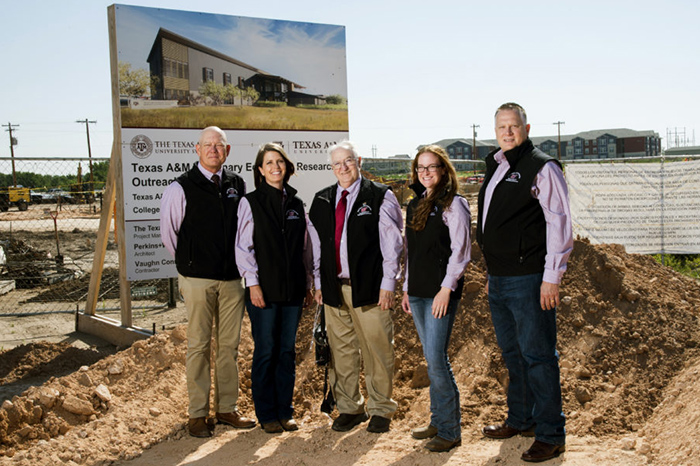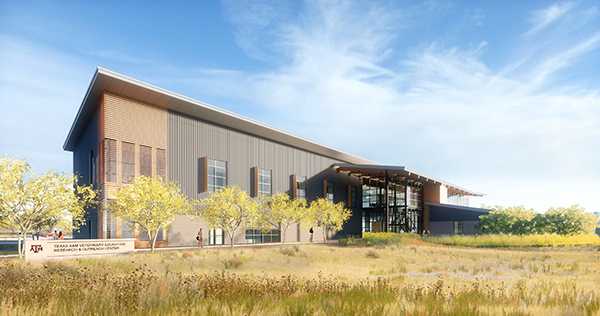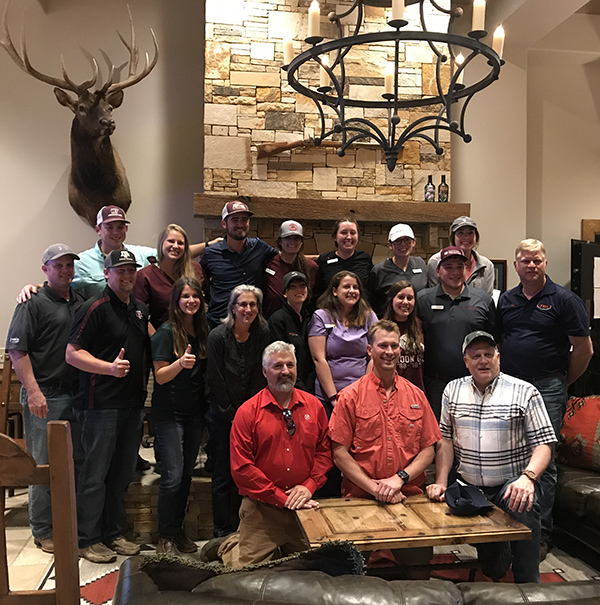VERO Partnership Serves Citizens of Texas Panhandle Through Education, Research, Outreach
Story by Dorian Martin
Story by Dorian Martin

A groundbreaking partnership between Texas A&M University’s College of Veterinary Medicine & Biomedical Sciences (CVM) and West Texas A&M University’s (WTAMU) ) Paul Engler College of Agriculture & Natural Sciences (PECANS) has created an infrastructure that connects students and researchers from the two Texas A&M University System entities to the citizens of the Texas Panhandle, including producers of a significant portion of the nation’s food livestock industry as well as with rural veterinarians.
This partnership, known as the Veterinary Education, Research, & Outreach (VERO) program, is an outgrowth of CVM’s Serving Every Texan Every Day initiative that was launched in 2009. VERO was created through the combined vision of Dr. Eleanor Green, the Carl B. King Dean of Veterinary Medicine at Texas A&M, and Dr. Dean Hawkins, then-dean of PECANS.
The partnership places senior CVM faculty members, including VERO program director Dr. Dee Griffin, VERO academic coordinator Dr. Dan Posey, and VERO research director Dr. Paul Morley, on WTAMU’s campus in Canyon, where they work collaboratively with WTAMU’s Department of Agricultural Sciences to support the citizens, students, and stakeholders of West Texas.
“VERO was designed to address the shortage of large animal veterinarians in the rural communities and to meet the needs of the food animal industry located in the Texas Panhandle and surrounding service areas,” said Dr. Lance Kieth, department head of WTAMU’s Department of Agricultural Sciences. “The premise of the VERO program is to attract students from rural communities to university pre-veterinary training programs, help prepare them for admission to veterinary schools of medicine, and then have them return to the rural communities to live and practice their profession.”
VERO taps into WTAMU’s prime location in Canyon, which is at the heart of the U.S. food livestock industry.
Approximately 30 percent of the nation’s beef cattle are fed or finished in the region, which includes the Texas Panhandle and parts of Oklahoma, Kansas, Colorado, and New Mexico. The area is home to 2.5 million beef cattle at any given time, as well as a large number of dairy cattle and swine.
“One of the reasons this initiative is so unique is that while many veterinary schools in the country were set up in strong agriculture areas—particularly those in universities with land grant status such as Texas A&M—that is no longer the case,” Morley said. “When these veterinary schools were established 100-125 years ago, cattle and horses were everywhere. Now, while many of those schools work to maintain ties to agriculture, they are not located where the animals are concentrated.”

The VERO program also encourages both WTAMU and CVM students to learn more about the unique opportunities that are available for veterinarians serving rural communities.
“One of the really neat things about being a veterinarian in a rural community is that you’re part of the community. You work with the school board, fair board, church board, with the 4-H Club, the FFA, the Boy Scouts; you have science projects cooking in your clinic. You own that community and they own you, and they love it,” Griffin said.
That introduction to the importance of rural veterinary medicine starts early for WTAMU students, who are taught by the CVM’s VERO faculty.
For example, Posey teaches a foundational “Agriculture Leadership” course for WTAMU freshmen who are interested in becoming veterinarians. He uses these courses to help students transition from high school to college and to set them on a path to be ready for veterinary school.
In addition, the VERO faculty also serve as advisers and mentors to pre-veterinary medicine students at WTAMU, as well as for those at eight other higher education institutions in the Texas Panhandle.
This year, there were more than 300 freshmen in WTAMU’s Department of Agricultural Sciences. Of those, more than a third were enrolled in pre-veterinary advising programs, with a total of 269 WTAMU pre-veterinary students enrolled in the fall 2019 semester.
“The secret is out. The combination of our location in the major livestock production region of the state/nation and the high-quality, affordable education available at WTAMU has resulted in large enrollment increases in animal science and pre-veterinary programs,” said Dr. Kevin Pond, WTAMU’s PECANS dean. “Students are coming from across Texas and the nation. Our new, state-of-the-art facilities and expanding number of excellent faculty will continue to attract the best and brightest students interested in animal agriculture and careers in veterinary medicine.”
In addition, Kieth pointed out that students who choose to attend WTAMU for their pre-veterinary training will reduce their overall cost of pursuing a Doctor of Veterinary Medicine (DVM) degree because of the affordability of WTAMU’s pre-veterinarian program.
VERO also offers multiple avenues to bring CVM students from College Station to Canyon so they see first-hand the many opportunities that are available for working in West Texas.
For example, CVM students have the opportunity to participate in the intensive six-day VERO Food Animal Production & Rural Practice Tour that involves visits to a variety of companies involved in the Texas Panhandle food animal industry, as well as to rural veterinary practices. That program recently celebrated the milestone of having its 100thCVM veterinary student participate in the tour.

Additionally, the VERO Food Animal & Rural Practice Summer Internship Program provides CVM students intensive training opportunities while working full-time in the daily activities of beef, dairy, and swine operations, as well as with rural veterinary practices. Fifteen veterinary students have spent the summer in the Panhandle in the program’s first three years, and because of its increased popularity, Posey estimates that 10 veterinary students will participate next year.
During their yearlong, fourth-year clinical rotations with the Texas A&M Veterinary Medical Teaching Hospital (VMTH), CVM students currently also have the opportunity to participate in an equine dentistry rotation and a community connections rotation led by the CVM’s Veterinary Emergency Team (VET).
The community connections rotation focuses on helping animal industries develop continuity of operations plans in the event of a natural disaster or an infectious disease epidemic.
“CVM students have designed a plan to guide professionals if, for example, foot-and-mouth infection was diagnosed in the Panhandle, so the feed yards that we work with would have a plan to keep it out of their feed yard,” Posey said.
There are even more opportunities in store for the CVM’s veterinary students; starting in May 2020, fourth-year CVM students can also participate in a number of Panhandle-specific clinical rotations that will allow them to get experience in feedlots, dairies, and mixed practices working and learning in the region two weeks at a time.
In addition to the growing education and outreach programs, VERO is expanding its research agenda through hiring additional faculty members and researchers. The research being undertaken is directly tied to industry’s needs.
“The tremendous numbers of animals located in the region provide a huge economic boon for the state. Having research faculty out here addressing important research problems is a win-win for everyone,” Morley said. “What we’re promoting in our research program is a strong tie to the industry in terms of hearing their important needs—what problems they need us to work on and then performing research that helps them to be financially successful and environmentally sustainable.”
For more information on VERO, visit vetmed.tamu.edu/vero.
###
For more information about the Texas A&M College of Veterinary Medicine & Biomedical Sciences, please visit our website at vetmed.tamu.edu or join us on Facebook, Instagram, and Twitter.
Contact Information: Jennifer Gauntt, Interim Director of CVM Communications, Texas A&M College of Veterinary Medicine & Biomedical Science; jgauntt@cvm.tamu.edu; 979-862-4216


